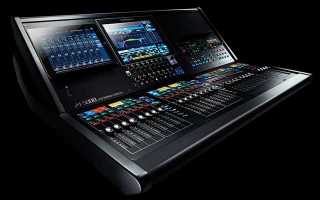Roland unveils M-5000 console with Dante and O.H.R.C.A configurability
Published: ASIA

WORLD: Roland Systems Group has introduced its largest digital console yet, boasting 24-bit/96kHz resolution, a newly-developed configurable architecture technology named O.H.R.C.A which promises ‘128 fully-definable audio paths’, and, for the first time, compatibility with third-party networking protocols including Dante. Named the M-5000, the console was announced in a global product launch on November 4th, and is primarily aimed at the touring sound market.
The result of a two-year, international development project, the M-5000 is intended to mark a new push for Roland into professional markets. While its primary target is live touring, it is also expected to penetrate the installation, theatre and broadcast sectors. ‘It is a significant launch, not just for us but for engineers who have always worked in a certain way – we want to challenge that,’ explained Roland Systems Group’s Peter Heath.
Headlining a bold feature-set is the M-5000’s Open High Resolution Configurable Architecture (O.H.R.C.A), which is being presented as an alternative to traditional fixed channel input/output busses. Instead, the console’s internal mix architecture can be tailored to specific applications within a range of up to 128 freely definable audio paths, any of which can be assigned as required. ‘In the past we’ve been used to saying here are your inputs, here are your auxiliaries, here are your outputs,’ added Mr Heath. ‘Those rules have now gone for the M-5000. You can make it whatever you want it to be.’
Meanwhile, the addition of third-party networking protocols represents a major shift in policy for the manufacturer, reflecting its professional ambitions for the M-5000. In the past, Roland has chosen to focus on its own REAC system. While REAC remains an option on the M-5000, the console also optionally supports Madi, Waves Soundgrid and Dante, with expansion slots to future-proof against emerging standards. Mr Heath described the addition as Roland responding ‘to the voice of the market’.
Physically, the surface operation is based around a 12-inch touchscreen, 28 faders in four banks including four assignable faders, plus an additional assignable section comprising four encoders, eight buttons and an OLED. Remote operation will also be possible using M-5000 RCS software for both Mac and Windows, while an iPad app named M-5000 Remote is due for arrival in the second quarter of 2015.
Among those central to the development of the M-5000 was Nico Suarez of Roland Systems Group. Referring to the console’s features and particularly O.H.R.C.A, he concluded, ‘We are assuming that some workflows in the digital mixer domain are already standards in the market so we’re bringing a new, second generation set of features that will lead the second era of digital consoles. No more fixed configuration between input channels and output busses anymore – we’re giving users the ability to build their own mixer and choose their preferred workflow.’
